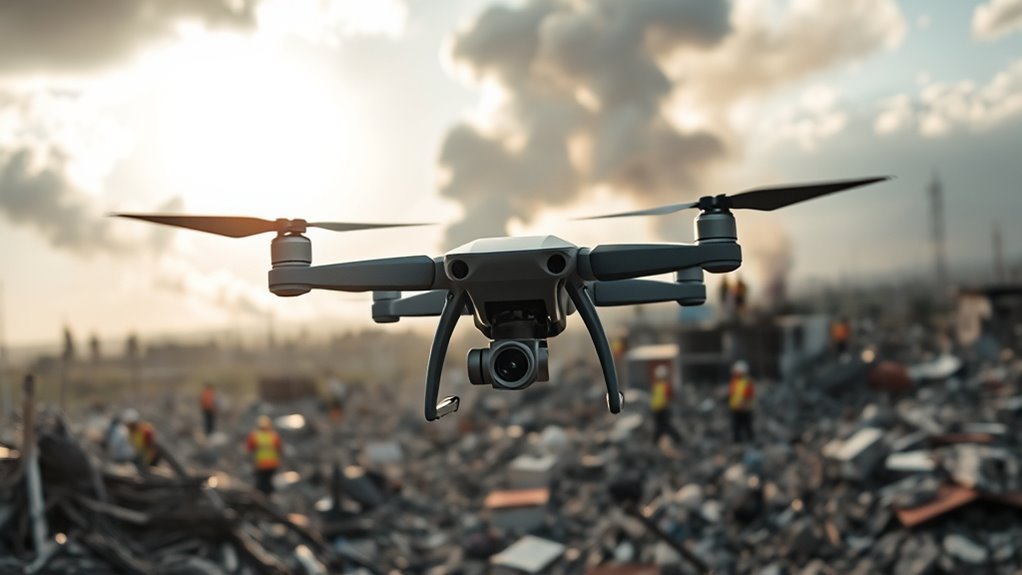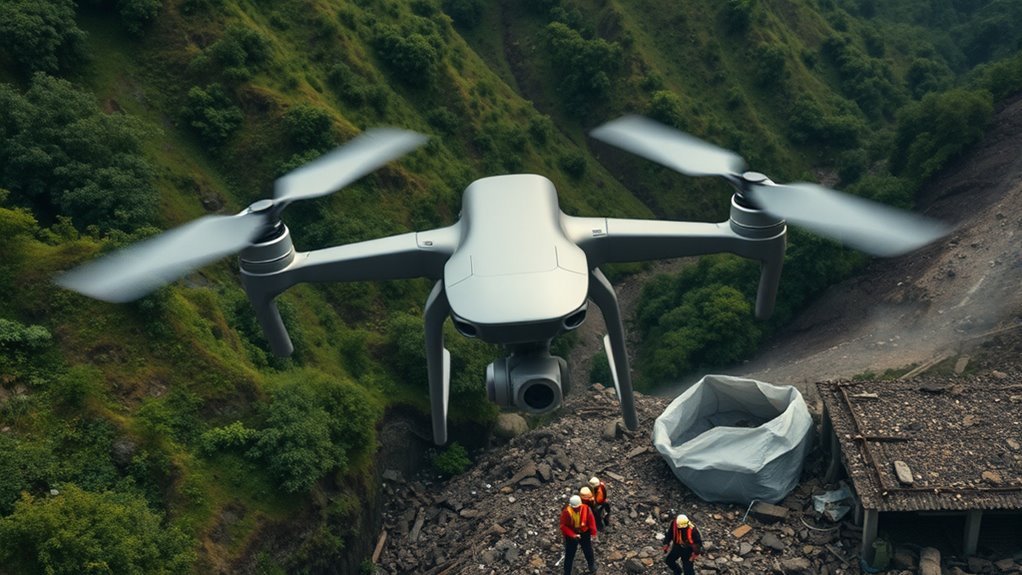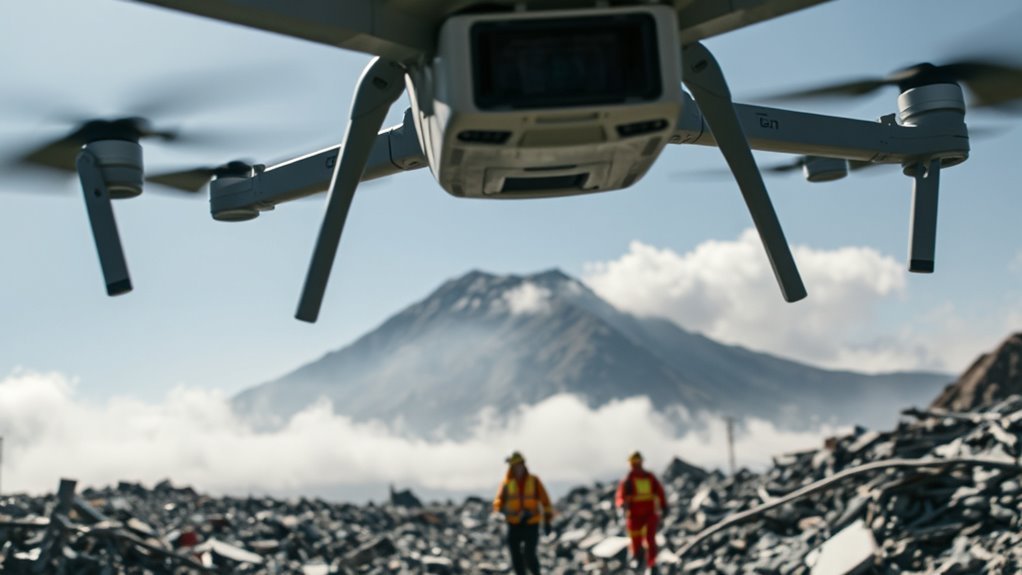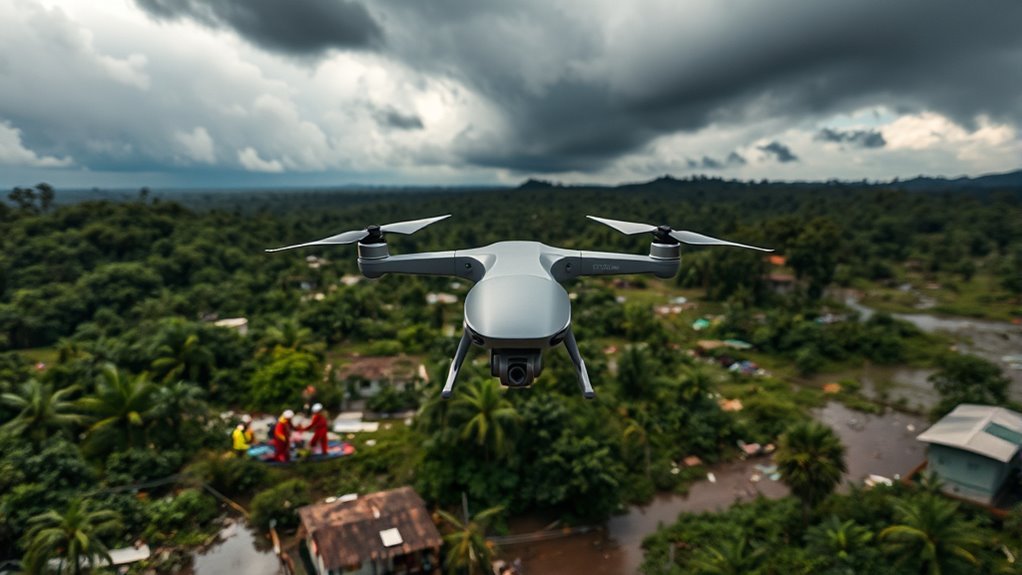You’ll find drones essential in disaster management, offering real-time aerial data that enhances situational awareness and speeds decision-making. Their varied technologies—fixed-wing for coverage, multirotor for precision, and advanced sensors—enable effective damage assessment and resource allocation. While you’ll face challenges like regulatory constraints, limited battery life, and privacy concerns, ongoing advancements in AI, communication, and training promise improved integration. Exploring these aspects reveals how drones reshape emergency response strategies for better outcomes.
Overview of Drone Technologies in Disaster Management

Although drones have been used in various industries, their integration into disaster management has considerably enhanced response capabilities. You’ll find multiple drone types optimized for different disaster scenarios—fixed-wing drones offer extended flight times for large-area surveillance, while multirotor drones provide precise maneuverability for close-up inspection. Technology advancements have expanded sensor payloads, incorporating thermal imaging, LiDAR, and high-resolution cameras, enabling detailed situational awareness in real-time. You can leverage autonomous navigation and AI-driven analytics to rapidly assess damage, locate survivors, and prioritize response actions. These enhancements reduce human risk and increase operational efficiency. Additionally, improvements in communication links and battery life extend deployment durations and data transmission reliability. By understanding these drone types and technology advancements, you gain the freedom to select appropriate platforms tailored to specific disaster contexts, ensuring agile and informed decision-making. This technological evolution empowers responders to act decisively, transforming raw data into actionable intelligence during critical moments.
Case Studies Highlighting Drone Deployment in Emergencies

When disaster strikes, drones have proven indispensable in delivering rapid, accurate assessments that conventional methods can’t match. Case studies from recent emergency responses illustrate this clearly. In the 2018 California wildfires, drones provided real-time aerial imagery, enabling responders to map fire progression and allocate resources efficiently. Similarly, after the 2020 Beirut explosion, drone surveys identified structural damages inaccessible to ground teams, accelerating damage assessment and prioritizing rescue efforts. Another case study from the 2019 Cyclone Idai in Mozambique showed drones mapping flood extents, guiding humanitarian aid delivery where roads were impassable. These examples underline drones’ ability to enhance situational awareness, reduce human risk, and improve decision-making speed. By analyzing these case studies, you see how drone integration transforms emergency response, offering freedom from traditional constraints. As you explore these documented deployments, it becomes evident that drones are not just tools but critical assets shaping modern disaster management strategies.
Benefits of Using Drones for Disaster Response

Because drones can access hazardous or hard-to-reach areas quickly, they considerably enhance the speed and accuracy of disaster response efforts. You benefit from real time data and aerial surveillance that streamline search operations and damage assessment. This rapid situational awareness improves resource allocation and logistics support, enabling you to deploy aid effectively. Drones also bolster communication enhancement by relaying critical information when infrastructure is compromised. Their role extends to environmental monitoring, helping you track hazards like floods or wildfires with precision.
| Benefit | Impact |
|---|---|
| Real time data | Enables immediate decision-making |
| Search operations | Increases coverage and efficiency |
| Resource allocation | Optimizes deployment of assets |
Challenges and Limitations in Drone Utilization
While drones offer significant advantages in disaster management, you’ll face several challenges and limitations that can affect their effectiveness. Regulatory hurdles often restrict drone deployment, requiring strict compliance with airspace and privacy laws. Technical limitations such as limited battery life, payload capacity, and susceptibility to weather conditions constrain operational scope. Public perception issues, including privacy concerns and fear of surveillance, may impede community acceptance. Data security is essential, as sensitive information gathered must be safeguarded against breaches. Operational costs, encompassing acquisition, maintenance, and deployment expenses, can strain budgets. Environmental concerns arise from potential wildlife disturbance and ecological impact during flights. Training requirements demand skilled operators proficient in drone technology and disaster protocols, which can delay rapid response. Finally, integration issues with existing disaster management systems can hinder seamless data sharing and real-time decision-making. Recognizing these challenges helps you develop strategies to optimize drone utility despite inherent constraints.
Future Directions for Drone Integration in Disaster Frameworks
As drone technology advances, you’ll see increasing opportunities to enhance disaster management frameworks through improved integration. Future directions hinge on aligning regulatory frameworks with rapid technology advancements, ensuring ethical considerations and policy implications keep pace. Emphasizing community engagement and robust training programs will empower operators and stakeholders alike. Effective data integration across platforms will streamline decision-making and resource allocation. Cost analysis remains critical to justify investments and scalability.
| Focus Area | Key Considerations |
|---|---|
| Regulatory Frameworks | Harmonization, compliance, adaptive policies |
| Technology Advancements | AI integration, extended flight times |
| Community Engagement | Participatory planning, local capacity building |
| Training Programs | Simulation-based learning, certification |
| Data Integration | Real-time analytics, interoperability |

